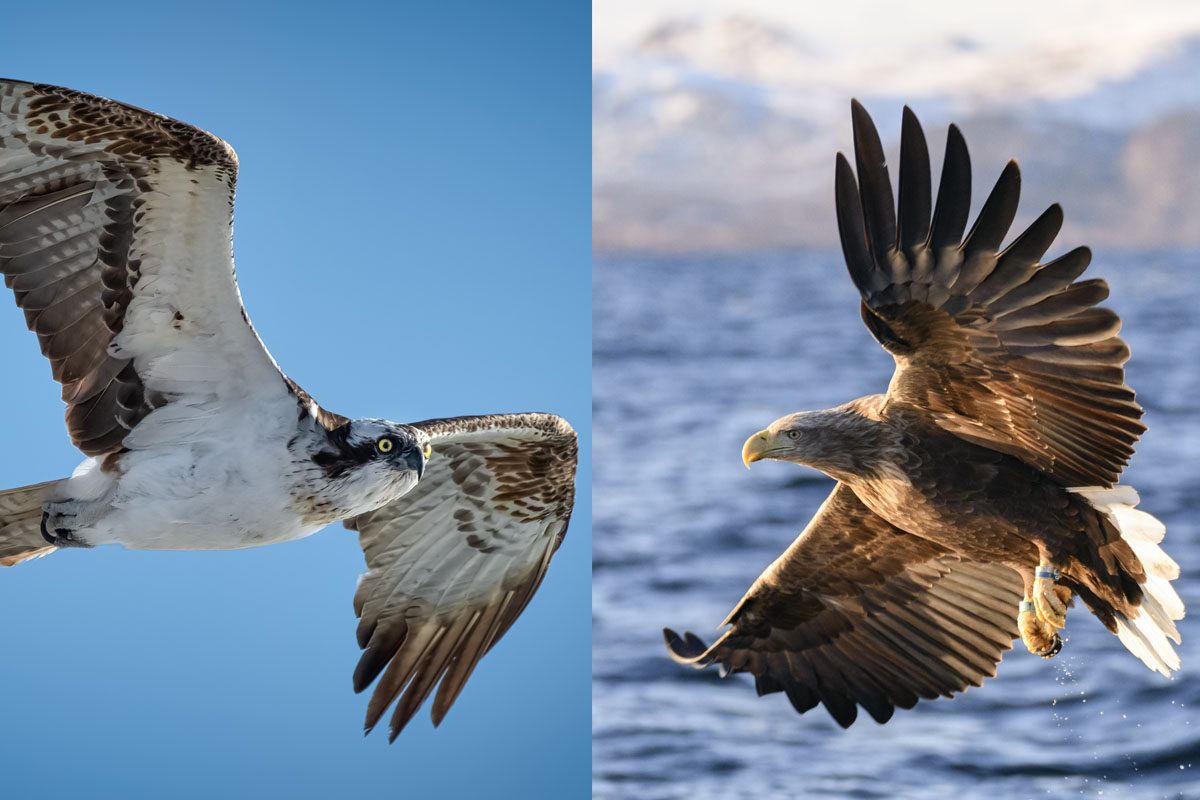
Are you a bird enthusiast with a passion for raptors?
If so, then you’ve undoubtedly crossed paths with the awe-inspiring hawks and ospreys. These magnificent creatures command our attention with their soaring flights and razor-sharp talons.
But how can we discern one from the other? Fear not, fellow bird lovers.
In this blog post, we’ll take a deep dive into the distinguishing characteristics that set hawks and ospreys apart. From their striking physical traits to their preferred habitats and hunting techniques, we’ll equip you with all the knowledge you need to confidently identify these remarkable birds.
So, buckle up and get ready for an exhilarating journey as we unravel the secrets of telling hawks and ospreys apart.
How can you tell the difference between a hawk and an osprey
Contents
- 1 How can you tell the difference between a hawk and an osprey
- 2 Physical Characteristics of Hawks and Ospreys
- 3 Coloration Differences in Hawks and Ospreys
- 4 Behavioral Differences between Hawks and Ospreys
- 5 Habitat Preferences of Hawks and Ospreys
- 6 Identifying Key Features of Hawks and Ospreys
- 7 Tips for Differentiating Between Hawks and Ospreys
- 8 How to Use Field Guides for Identification Purposes
- 9 Seek Expert Advice When Necessary
- 10 Conclusion
These magnificent creatures share some similarities, but there are key characteristics that can help you tell them apart. In this blog post, we will delve into the physical traits, behaviors, habitats, and diets of hawks and ospreys to equip you with the knowledge to differentiate between these fascinating birds.
Physical Characteristics:
Hawks:
- Size: Hawks are generally larger than ospreys, with a wingspan ranging from 3 to 5 feet.
- Shape: They have broad wings and a compact body, perfect for swift flight.
- Coloration: Hawks display a variety of plumage colors, including brown, black, gray, and white.
Ospreys:
- Size: Ospreys have an average wingspan of 5 to 6 feet.
- Shape: Their wings are more elongated with a distinct bend at the midpoint.
- Coloration: Ospreys have predominantly brown upperparts and white underparts.
Behaviors:
Hawks:
- Hunting Techniques: Hawks are skilled hunters that catch prey in flight or from perches.
- Nesting Habits: They build nests high in trees or on cliffs using sticks and twigs.
Ospreys:
- Hunting Techniques: Ospreys are excellent fishers and primarily feed on live fish. They hover above water bodies before diving feet-first to snatch fish with their sharp talons.
- Nesting Habits: Ospreys construct large nests made of sticks near bodies of water.
Habitat:
Hawks:
- Distribution: Hawks can be found in various habitats worldwide, including forests, grasslands, deserts, and urban areas.
- Nesting Preferences: They prefer secluded areas away from human disturbances.
Ospreys:
- Distribution: Ospreys have a more restricted distribution and are commonly found near bodies of water such as coastlines, lakeshores, and rivers.
- Nesting Preferences: They build nests in accessible locations near water bodies.
Diet:
Hawks:
- Prey Preference: Hawks have a diverse diet that includes small mammals, birds, reptiles, and insects. Some species are specialized hunters that focus on specific prey.
- Hunting Techniques: Hawks employ various hunting techniques, such as soaring, scanning from perches, or engaging in high-speed chases.
Ospreys:
- Prey Preference: Ospreys predominantly feed on fish, making it the majority of their diet.
- Hunting Techniques: Ospreys use a unique hunting technique called “plunging,” where they dive into the water feet-first to catch fish.
Physical Characteristics of Hawks and Ospreys
In the mesmerizing world of birds, hawks and ospreys stand out as fierce and captivating predators. While they share the same avian lineage as birds of prey, these two species possess unique physical characteristics that make them easily distinguishable. Join me on this adventure as we explore the physical traits that set hawks and ospreys apart.
Size Matters:
Hawks take the lead in terms of size, boasting an impressive wingspan averaging between 3 to 4 feet. On the other hand, ospreys sport slightly smaller wingspans, ranging from 5 to 6 feet. This difference in size is evident when observing these birds in flight, with hawks appearing more robust and ospreys displaying a leaner physique.
Shape-Shifting Flyers:
When it comes to wing shape, hawks and ospreys have adapted to suit their distinct hunting styles. Hawks possess broad and rounded wings, enabling them to effortlessly soar through the sky while scanning the ground for prey. In contrast, ospreys flaunt long and narrow wings that facilitate their incredible diving skills when hunting fish.
Flight Patterns:
In the realm of flight, hawks exhibit exceptional agility and speed as they maneuver through forests and urban landscapes in pursuit of their quarry. On the other hand, ospreys showcase a remarkable hovering flight pattern, allowing them to remain stationary in mid-air while scanning the water below for unsuspecting fish.
A Splash of Color:
Hawks exhibit a diverse range of colors depending on their species, but most commonly they boast brown or gray feathers adorned with darker markings. Conversely, ospreys flaunt a distinctive black and white plumage with brown patches on their upper wings. These unique colorations make them easily identifiable in their respective habitats.
Head over Beak:
The beaks of hawks and ospreys are perfectly adapted for their distinct hunting strategies. Hawks possess large and powerful beaks with curved tips, ideal for ripping apart their prey. In contrast, ospreys wield sharp and hooked beaks designed specifically for catching and gripping slippery fish.
Eagle Eyes:
Both hawks and ospreys possess remarkable eyesight, but hawks are renowned for their exceptional long-distance vision. Their eyes are positioned more towards the sides of their heads, granting them a broader field of view.
Ospreys, however, have forward-facing eyes, enabling them to accurately judge distances as they plunge into the water after their piscine targets.
Talons and Toes:
Sharp and curved talons are a common feature among both hawks and ospreys, serving as formidable tools for grasping onto their prey.
However, ospreys possess an additional advantage with specialized reversible outer toes that can rotate forward or backward. This unique adaptation aids in gripping fish firmly while in flight.
Coloration Differences in Hawks and Ospreys
Today, we embark on an exciting journey to explore the mesmerizing world of hawks and ospreys. These majestic birds of prey captivate us not only with their incredible hunting skills but also with their distinct coloration.
Join me as we compare and contrast the vibrant plumage of hawks and the striking hues of ospreys.
Hawks: A Palette of Diversity
Hawks, belonging to the Accipitridae family, showcase an impressive range of color variations. Their plumage can include shades of brown, gray, black, and white. Each species of hawk possesses its unique color palette, making identification a thrilling challenge for birdwatchers. Some hawks exhibit patterns such as spots or bars, adding an extra touch of elegance to their appearance.
Ospreys: The Classic Brown and White
Unlike the diverse coloration seen in hawks, ospreys sport a more standardized look. Their upperparts are predominantly brown, while their underparts are a crisp white. These contrasting colors make ospreys easily recognizable even from a distance. Additionally, their heads and necks boast a pristine white hue adorned with a distinctive dark eye stripe, adding a touch of sophistication to their regal appearance.
Wings Tell a Tale
When it comes to wing coloration, hawks and ospreys exhibit noticeable differences. Hawks tend to have wings that match their body coloration or may be slightly darker. This harmonious blend helps them blend into their surroundings during hunting expeditions.
On the other hand, ospreys sport dark brown wings with a striking white patch near the base of the primaries. This contrasting feature is an excellent visual clue for identifying these magnificent birds in flight.
Tails: A Splash of Contrast
The tail feathers of hawks and ospreys further differentiate the two species. Hawks often possess banded or barred tails that match their body coloration, creating a seamless flow in their appearance.
In contrast, ospreys flaunt a solid dark brown tail with a prominent white band towards the end. This striking contrast serves as a striking visual marker that sets them apart from their hawk counterparts.
As we conclude our exploration of the coloration differences in hawks and ospreys, we realize how these remarkable birds captivate our senses not only with their hunting prowess but also with their stunning appearances.
By paying attention to their overall body coloration, wing patterns, and tail colors, bird enthusiasts can further appreciate and identify these magnificent creatures in the wild.
Behavioral Differences between Hawks and Ospreys
Hunting Behavior:
- Hawks: Known for quick and agile flight, soaring high in the sky and diving down to catch prey. Skilled hunters with keen eyesight.
- Ospreys: Skilled hunters that dive into water to catch fish. Specially adapted feet with sharp, curved talons.
Nesting Habits:
- Hawks: Build nests in trees or on cliffs. Nests are smaller and made of twigs and branches.
- Ospreys: Build nests near bodies of water such as rivers or lakes. Nests are large and made of sticks.
Territorial Behavior:
- Hawks: Fiercely defend their territory, diving and swooping at intruders. Aggressive behavior to protect nesting sites and hunting grounds.
- Ospreys: Less territorial and more tolerant of other birds. May share nesting areas with other ospreys or different bird species.
Social Behavior:
- Hawks: Solitary birds, prefer to hunt alone or in pairs. Highly independent, rarely form large groups or flocks.
- Ospreys: Can be seen in small groups during migration or when there is an abundance of food. More social, may engage in aerial displays with other ospreys.
Migration Patterns:
- Hawks: Long-distance migration, traveling thousands of miles to reach wintering grounds. Strong instinct for navigation, finding their way back to the same nesting site.
- Ospreys: Migration distances shorter compared to hawks. Travel hundreds of miles, often following coastlines or major rivers.
Vocalizations:
- Hawks: Piercing screams and screeches used for communication and territorial defense.
- Ospreys: Distinctive high-pitched whistle or cheeping call heard near nesting sites.
Habitat Preferences of Hawks and Ospreys
When it comes to birds of prey, hawks and ospreys are two distinct species with unique habitat preferences. While hawks are versatile and can adapt to various environments, ospreys have a more specialized preference for habitats near water bodies.
Let’s dive into the details and uncover the fascinating differences between these magnificent raptors.
Habitat Preferences of Hawks:
Hawks are true masters of adaptation, thriving in a wide range of habitats. Whether it’s a dense forest, open fields, grasslands, or even urban areas, hawks can be found surveying their surroundings with keen eyesight.
They prefer nesting in tall trees or on cliffs, offering them an elevated vantage point to spot their prey from a distance. Hawks are territorial birds, fiercely defending their nesting area from intruders and predators.
Habitat Preferences of Ospreys:
Ospreys, also known as fish hawks, have a more specific habitat preference. These majestic birds are most commonly found near bodies of water such as rivers, lakes, and coastal areas.
Their primary food source is fish, so it’s vital for them to be close to water bodies where they can hunt with precision.
Ospreys construct large nests made of sticks and other materials near the water’s edge, often on top of structures like utility poles or dead trees. These nests provide them with a perfect vantage point to spot fish swimming beneath the surface.
Migration and Travel:
While hawks tend to remain in their chosen habitat year-round, ospreys are migratory birds that undertake long journeys to find suitable breeding grounds and feeding areas.
During migration, ospreys can be observed along coastlines or soaring over vast bodies of water in search of fish-rich locations. Their incredible navigational abilities allow them to travel thousands of miles, making them true globetrotters of the avian world.
Comparing Hawks and Ospreys:
| | Hawks | Ospreys |
|————-|———————————-|——————————-|
| Habitat | Forests, fields, grasslands, urban areas | Near bodies of water (rivers, lakes, coastal areas) |
| Nesting | Tall trees, cliffs | Near water’s edge on structures like utility poles or dead trees
| Food Source | Varied prey, adaptable | Fish hunting specialists |
| Migration | Non-migratory | Migratory birds traveling long distances |
Identifying Key Features of Hawks and Ospreys
When it comes to identifying hawks and ospreys, there are several key features to consider. These birds of prey may share some similarities, but they also have distinct physical characteristics that set them apart.
Let’s take a closer look at these features and how they can help you differentiate between hawks and ospreys.
Size:
One of the first things to consider is the size of the bird. Hawks are generally smaller, with a wingspan ranging from 2 to 4 feet.
Ospreys, on the other hand, have a larger wingspan, typically measuring 5 to 6 feet. This size difference can be quite noticeable when observing these birds in flight.
Coloration:
Coloration is another important feature to look for. Hawks come in a variety of colors, depending on the species. Common colors include brown, gray, and white.
Ospreys, however, have a more distinct appearance. They have dark brown upper parts and white underparts, with a distinctive white crown on their heads.
Body Shape:
The body shape of these birds is also worth noting. Hawks tend to have broad wings and a compact body, which aids in their agility and maneuverability during hunting.
Ospreys, on the other hand, have long and narrow wings that are adapted for soaring and diving into water to catch fish.
Hunting Behavior:
Hawks and ospreys have different hunting behaviors. Hawks rely on exceptional eyesight and agile flight to catch small mammals and birds in mid-air.
Ospreys, on the other hand, are specialized fish-eaters. They have evolved unique adaptations such as reversible outer toes and spiny pads on their feet to help grip slippery fish.
Beak Shape:
The shape of the beak can also provide clues for identification. Hawks have a hooked beak that is sharp and curved downwards, allowing them to tear apart their prey.
Ospreys, on the other hand, have a curved beak with sharp edges that is specifically adapted for gripping and manipulating fish.
Habitat Preferences:
Both hawks and ospreys have specific habitat preferences. Hawks are versatile and can be found in a variety of environments such as forests, open fields, and even urban areas.
Ospreys, on the other hand, are primarily found near bodies of water such as rivers, lakes, and coastal areas where they can find their preferred prey – fish.
Tips for Differentiating Between Hawks and Ospreys
Among these formidable predators, hawks and ospreys stand out as two distinct species. While they may share some similarities, there are key physical characteristics, hunting techniques, habitats, and vocalizations that can help differentiate between these magnificent birds.
In this article, we will explore five tips to help you distinguish between hawks and ospreys.
Size and Wing Shape:
One of the first things to note when differentiating between hawks and ospreys is their size and wing shape. Hawks tend to be larger, with longer wingspans and broader bodies.
Their broad wings are built for soaring and gliding through the air. Ospreys, on the other hand, are smaller in size with shorter wingspans and narrower wings that are specially adapted for diving into water to catch fish.
Plumage and Beak Shape:
The plumage of hawks and ospreys also sets them apart. Hawks exhibit a diverse range of colors in their feathers, including shades of brown, gray, and white. Some hawks even have distinctive patterns or markings on their feathers.
In contrast, ospreys have a more consistent appearance with dark brown upperparts and white underparts. Furthermore, their beak shapes differ as well. Hawks have sharp, curved beaks designed for tearing flesh and capturing prey on land, while ospreys have hooked beaks that excel at gripping slippery fish.
Habitat Preference:
Observing their habitat preferences can also aid in identification. Hawks are adaptable birds that can be found in various environments such as forests, grasslands, and even urban areas.
They are versatile hunters that can thrive in different ecosystems.
On the other hand, ospreys are often associated with bodies of water like lakes, rivers, and coastal regions. They rely on these aquatic habitats to find fish, their primary food source.
Hunting Techniques:
The hunting techniques of hawks and ospreys provide further clues for identification. Hawks are agile predators that rely on their exceptional vision to spot prey from a distance. They utilize their speed and agility to swoop down on land or in the air to catch their targets.
Ospreys, however, have a unique fishing technique. They hover above the water surface before diving headfirst into the water with their talons extended to snatch fish. This diving behavior is a distinctive characteristic of ospreys and is rarely seen in hawks.
How to Use Field Guides for Identification Purposes
When it comes to identifying birds of prey like hawks and ospreys, field guides are your best friends. These handy books provide detailed information, illustrations, and photographs to help you distinguish between these magnificent creatures.
Here, we’ll explore how to use field guides effectively for accurate identification, so you can confidently spot the difference between hawks and ospreys.
Size Matters:
The first clue to differentiate between hawks and ospreys lies in their size. Hawks are generally larger, with a wingspan of 3 to 4 feet, while ospreys boast impressive wingspans ranging from 5 to 6 feet. So, if you spot a bird soaring above with a massive wingspan, you’re likely looking at an osprey.
Wing Shape:
Take a closer look at the shape of the bird’s wings. Hawks have broad wings with rounded tips, perfect for gliding through the sky in search of prey. On the other hand, ospreys have narrower wings with a distinctive kink or bend in the middle known as a “crook.” This specialized wing shape allows them to dive into water to catch fish.
Coloration Clues:
Examining the coloration of the bird is another helpful step. Hawks usually have dark brown or grayish-brown feathers on their upper parts and lighter underparts. Some hawks may even sport distinct patterns like bands or spots on their feathers. In contrast, ospreys have a striking contrast between their dark brown upperparts and white underparts.
Facial Features:
Looking closely at the bird’s face can reveal valuable clues for identification. Hawks often have a dark stripe running through their eyes known as an “eyebrow,” which adds to their fierce appearance. On the other hand, ospreys have a white head with a dark eye stripe that extends down the side of their face. These distinct facial markings make ospreys easily recognizable.
Behavior Matters:
Observing the bird’s behavior can also provide valuable insights for identification. Hawks are famous for their soaring flight and hunting techniques, such as perching and swooping down on prey. On the contrary, ospreys are skilled fishermen and can often be seen hovering above water before diving in feet-first to catch fish. So, if you spot a bird exhibiting impressive fishing skills, you’re likely observing an osprey.
Seek Expert Advice When Necessary
These birds can be quite tricky to tell apart, but fear not, seeking expert advice can be the key to becoming a pro at identifying them.
So, let’s dive into why it’s so important to consult the experts when it comes to hawks and ospreys.
- Subtle Differences: Hawks and ospreys may belong to the same raptor family, but they have distinct features that set them apart. Experts have an eagle-eye for these subtle differences that might not be easily noticed by the untrained eye. They can guide you through the distinguishing traits that make each bird unique.
- Clarifying Misconceptions: Sometimes, visual cues or behaviors can be misleading when trying to identify these birds. Experts can help clear up any confusion by debunking common mistakes or misconceptions people often make. This way, you’ll avoid falling into identification pitfalls and develop a more accurate understanding.
- Tips and Tricks for Observation: Want to spot these magnificent creatures in their natural habitats? Experts have insider knowledge on where and when to look for hawks and ospreys. They can provide tips on their preferred hunting grounds, nesting habits, and migratory patterns. With their guidance, you’ll significantly increase your chances of catching a glimpse of these awe-inspiring birds.
- Complementing Personal Efforts: Seeking expert advice doesn’t mean your personal research is in vain. On the contrary, consulting professionals in the field complements your individual efforts by providing reliable information and expertise. It’s like adding wings to your learning journey.
Remember, becoming a hawk and osprey identification pro takes time and practice. By combining your own research with expert advice, you’ll expand your knowledge base, refine your skills, and truly appreciate the beauty of these magnificent birds of prey. So, spread your wings and soar to new heights with expert guidance.
Conclusion
When it comes to distinguishing between a hawk and an osprey, there are several key factors to consider. First and foremost is their physical appearance. Hawks typically have shorter wingspans and broader wings than ospreys, which have longer wingspans and narrower wings. Additionally, hawks tend to have a more compact body shape compared to the slender build of an osprey.
Another important characteristic to observe is their behavior in flight. Hawks are known for their swift and agile flight patterns, often soaring effortlessly through the sky with quick turns and dives. On the other hand, ospreys have a distinct hovering technique where they suspend themselves mid-air before plunging into the water to catch fish.
Furthermore, their hunting habits can also provide clues for identification. Hawks are versatile predators that hunt a wide range of prey including small mammals, birds, and reptiles. Ospreys, however, specialize in catching fish from bodies of water using their sharp talons.
Lastly, their habitats can offer insights into telling them apart. Hawks are commonly found in various ecosystems such as forests, grasslands, and deserts. They prefer perching on trees or high vantage points to scan for potential prey. Conversely, ospreys are primarily found near bodies of water like lakes or rivers where they build large nests on platforms or structures like telephone poles.
In conclusion, by carefully observing physical characteristics, flight behaviors, hunting habits, and preferred habitats, one can confidently differentiate between hawks and ospreys.


